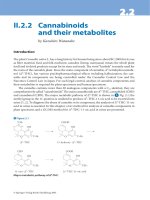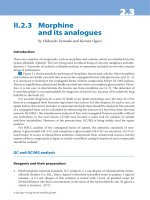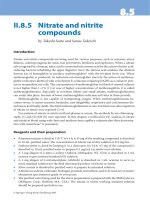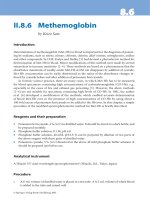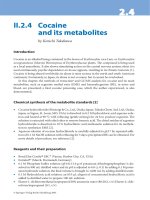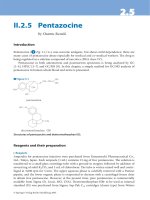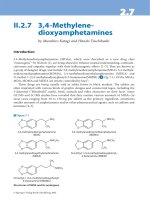Drugs and Poisons in Humans - A Handbook of Practical Analysis (Part 23)
Bạn đang xem bản rút gọn của tài liệu. Xem và tải ngay bản đầy đủ của tài liệu tại đây (207.19 KB, 5 trang )
2.52.5
© Springer-Verlag Berlin Heidelberg 2005
II.2.5 Pentazocine
by Osamu Suzuki
Introduction
Pentazocine (> Fig. 5.1) is a non-narcotic analgesic, but shows mild dependence; there are
many cases of pentazocine abuse especially for medical and co-medical workers. e drug is
being regulated as a subclass compound of narcotics (DEA class: IV).
Pentazocine in both antemortem and postmortem specimens is being analyzed by GC
[1–4], HPLC [5–7] and GC/MS [8]. In this chapter, a simple method for GC/MS analysis of
pentazocine in human whole blood and urine is presented.
Structures of pentazocine and dextromethorphan (IS).
⊡ Figure 5.1
Reagents and their preparation
i. Reagents
Ampoules for pentazocine injection were purchased from Yamanouchi Pharmaceutical Co.,
Ltd., Tokyo, Japan. Each ampoule (1 mL) contains 15 mg of free pentazocine. e solution is
transferred to a small glass centrifuge tube with a ground-in stopper, followed by addition of
several mg of solid K
2
CO
3
and 3 mL of chloroform. e tube is vortex-mixed well and centri-
fuged at 3,000 rpm for 5 min. e upper aqueous phase is carefully removed with a Pasteur
pipette, and the lower organic phase is evaporated to dryness with a centrifugal freeze drier
to obtain free pentazocine. However, at the present time, pure pentazocine is commercially
available from Sigma (St. Louis, MO, USA). Dextromethorphan-HBr to be used as internal
standard (IS) was purchased from Sigma; Sep-Pak C
18
cartridges (classic type) from Waters
220 Pentazocine
(Milford, MA, USA). Other common chemicals were of the highest purity commercially avail-
able.
ii. Preparation
• Pentazocine and dextromethorphan solutions: the drugs are separately dissolved in appro-
priate amount of methanol; a 10–20 µL aliquot was added to 1 mL of whole blood or
urine.
• 1 M NaHCO
3
: a 8.4-g aliquot of NaHCO
3
is dissolved in distilled water to prepare 100 mL
solution.
• Chloroform/ethanol (9:1, v/v): a 100-mL volume of the mixture is prepared.
GC/MS
conditions [8]
GC column
a
: a DB-17 fused silica capillary column (30 m × 0.32 mm i. d., lm thickness
0.25 µm, J&W Scienti c, Folsom, CA, USA).
GC conditions: a GC-17A gas chromatograph (Shimadzu Corp., Kyoto, Japan); column
(oven) temperature: 150 °C (1 min) → 20 °C/min → 280 °C; injection temperature: 280 °C;
carrier gas: He; its ow rate: 3 mL/min; injection: splitless mode for 1 min, followed by the split
mode.
MS conditions; instrument: a Shimadzu QP-5050A quadrupole mass spectrometer
b
con-
nected with the above GC; ionization: positive ion EI; electron energy: 70 eV; emission current:
60 µA; ion source temperature: 280 °C; accelerating voltage: 1.5 kV.
Procedure
i. To 1-mL of whole blood or urine, containing pentazocine, are added 50 ng dextromethor-
phan (IS, methanolic solution) and 6 mL distilled water, followed by mixing well. For a
whole blood specimen, it is necessary to con rm the complete hemolysis. A 3-mL volume
of 1 M NaHCO
3
solution is added to the above mixture to bring its pH to about 8.
ii. A 10-mL volume of ethanol and 10 mL distilled water are passed through a Sep-Pak C
18
cartridge using a 10-mL volume glass syringe to activate the cartridge at a ow rate not
faster than 5 mL/min.
iii. e cartridge is washed with 10 mL distilled water twice; pentazocine and IS are slowly
eluted with 3 mL of chloroform/ethanol (9:1) into a glass vial.
iv. A small amount of upper aqueous layer is carefully removed by aspiration with a Pasteur
pipette. e organic layer (chloroform) is evaporated to dryness under a stream of nitro-
gen. e residue is dissolved in 100 µL methanol; a 1-µL aliquot of it is injected into GC/
MS being operated in the selected ion monitoring (SIM) mode.
v. Ions at m/z 271 plus 214 are analyzed for the IS from 3 to 7 min, and those at m/z 285 plus
217 for pentazocine from 7 to 8 min by SIM
c
.
vi. A calibration curve is constructed by adding 50 ng IS and one of various concentrations of
pentazocine to each vial containing 1 mL of blank whole blood or urine and 6 mL distilled
water, followed by the above procedure. e number of di erent concentrations of pen-
tazocine should be not smaller than 4 for the calibration curve, which is composed of pen-
221
tazocine concentration in the horizontal axis and peak area ratio of pentazocine to IS in the
vertical axis. e peak area ratio of a test specimen is applied to the calibration curve to
obtain its pentazocine concentration.
Assessment of the method
> Table 5.1 shows EI mass spectra of pentazocine and IS. e base peaks unfortunately
appeared in a low mass range at m/z 70 and 59, respectively. erefore, the author et al. [8] used
the combined SIM mode as shown in Figure 5.2. Ions at m/z 271 (M
+
) plus 214 and at m/z 285
(M
+
) plus 217 were used for detection of IS and pentazocine, respectively. When SIM with a
single ion is made, ions at m/z 217 and 271 (M
+
) should be used for pentazocine and IS, respec-
tively.
e detection limits
d
(S/N=3) in the SIM mode were 20–30 ng/mL for pentazocine and
5–10 ng/mL for IS. e therapeutic concentrations of pentazocine in blood was reported to be
50–200 ng/mL; the acute toxic blood level more than 1 µg/mL [9]. erefore, the present
method can be used for detection and quantitation of both therapeutic and toxic levels of pen-
tazocine in blood.
e recovery of pentazocine using the Sep-Pak C
18
cartridge was close to 100 % for both
whole blood and urine [8].
In this method, dextromethorphan is used as IS; the drug is being widely used as an anti-
tussive and a fatal case, suggesting dextromethorphan poisoning, was reported [10]. To mea-
sure dextromethorphan, the same method can be used with pentazocine as IS conversely.
⊡ Table 5.1
EI mass spectra of pentazocine and dextromethorphan (IS)
Compound m/z (% peak intensity)
Pentazocine 70 (100) 110 (39) 217 (45) 270 (9) 285 (9)
IS 59 (100) 150 (17) 214 (9) 271 (17)
Poisoning case, and toxic and fatal concentrations
A 17-year-old female [11] ingested about 100 tablets of pentazocine (total amount estimated,
2.5 g) and fell into unconsciousness with convulsion like grand mal. She was sent to an emer-
gency room, but still showed general cyanosis, convulsions and severe tachycardia. Because of
her irregular spontaneous respiration, endotracheal intubation was accomplished and oxygen
supply started. Since she showed severe acidosis, 100 mg of sodium bicarbonate, 1.6 mg of
naloxone and diazepam (anticonvulsant) were administered to her. Her recovery was smooth,
and she got free of the arti cial respiration device a er 3 h; her consciousness became clear.
A 45-mg aliquot each of pentazocine was administered to 8 subjects intramuscularly. e
maximum blood concentrations were obtained 1 h a er the administration; they were 0.11–
0.24 µg/mL (average 0.14 µg/mL). A 75 mg aliquot each of pentazocine was orally administered
to 5 subjects; the maximum blood concentrations (0.11–0.30 µg/mL; average 0.16 µg/mL) were
obtained 1–3 h a er the administration [12].
Pentazocine
222 Pentazocine
SIM chromatograms for pentazocine (peak 2) and dextromethorphan (IS, peak 1) extracted from whole blood and urine. In this system, ions at m/z 271
plus 214 (IS) and at m/z 285 plus 217 (pentazocine) were used at the retention times of 3–7 min and 7–8 min, respectively. The amount of pentazocine
and IS spiked into 1 mL of blank whole blood or urine was equally 50 ng.
⊡ Figure 5.2
223
In two autopsy cases of pentazocine poisoning, its concentrations were 9.2 and 3.3 µg/mL in
blood, 43 and 34 µg/g in the liver, and not detectable and 4.5 µg/mL in urine, respectively [12].
e blood concentrations of dextromethorphan, which has been used as IS in this chapter,
were reported to be 100–950 ng/mL (average 380 ng/mL) in its poisoning fatal cases of infants
[10].
Notes
a) Any capillary column of a 50 % phenylsilicone/50 % dimethylsilicone stationary phase (in-
termediately polar) can be used, regardless of manufacturers.
b) Any type of GC/MS instruments, to which a capillary column can be attached, can be
used.
c) With a computer system unable to perform such combined SIM detection, the usual SIM
using a single ion can be made by the method described below.
d) In view of sensitivity only, GC-NPD was reported to give similar sensitivity to that of the
present GC/MS for pentazocine [1–3].
References
1) Mackell MA, Poklis A (1982) Determination of pentazocine and tripelennamine in blood of T,s and Blue addicts
by gas-liquid chromatography with a nitrogen detector. J Chromatogr 235:445–452
2) Schaffer MI, Lin RL, Wu-Chen NB et al. (1983) Spontaneous live birth with a maternal history of intravenous use
of pentazocine and tripelennamine, T,s and Blues. J Forensic Sci 28:489–495
3) Kintz P, Tracqui A, Lugnier AJ et al. (1990) Simultaneous screening and quantification of several nonopiate
narcotic analgesics and phencyclidine in human plasma using capillary gas chromatography. Method Find Exp
Clin Pharmacol 12:193–196
4) Hattori H, Suzuki O, Seno H et al. (1993) Sensitive determination of pentazocine in whole blood and urine by
gas chromatography with surface ionization detection. Jpn J Forensic Toxicol 11:31–36
5) Shibanoki S, Imamura Y, Itoh T et al. (1987) Application of high-performance liquid chromatography with elec-
trochemical detection for monitoring the concentration of pentazocine in human blood. J Chromatogr
421:425–429
6) Hackett LP, Dusci LJ, Ilett KF (1987) The analysis of several nonopiate narcotic analgesics and cocaine in serum
using high-performance liquid chromatography. J Anal Toxicol 11:269–271
7) Misztal G, Przyborowski L (1991) Determination of pentazocine in human plasma by high performance liquid
chromatography. Pharmazie 46:464–465
8) Seno H, Kumazawa T, Ishii A et al. (2000) Determination of pentazocine in human whole blood and urine by gas
chromatography/surface ionization organic mass spectrometry. J Mass Spectrom 35:33–38
9) Uges DRA (1997) Blood level data. In: Brandenberger H, Maes RAA (eds) Analytical Toxicology for Clinical,
Forensic and Pharmaceutical Chemists. Walter de Gruyter, Berlin, pp 707–718
10) Association of Medical Examiners, NAME, Pediatric Toxicology Registry, USA (1994) Dextromethorphan blood
concentrations in infants. Bull Int Assoc Forensic Toxicol 24 (1):38–39
11) Yamazaki F, Mori H (eds) (2000) Guide to Acute Poisonings by Medical Drugs. Van Medical, Tokyo, p 222 (in
Japanese)
12) Moffat AC, Jackson JV, Moss MS et al. (eds) (1986) Clarke’s Isolation and Identification of Drugs, 2nd edn. The
Pharmaceutical Press, London, pp 860–861
Pentazocine


